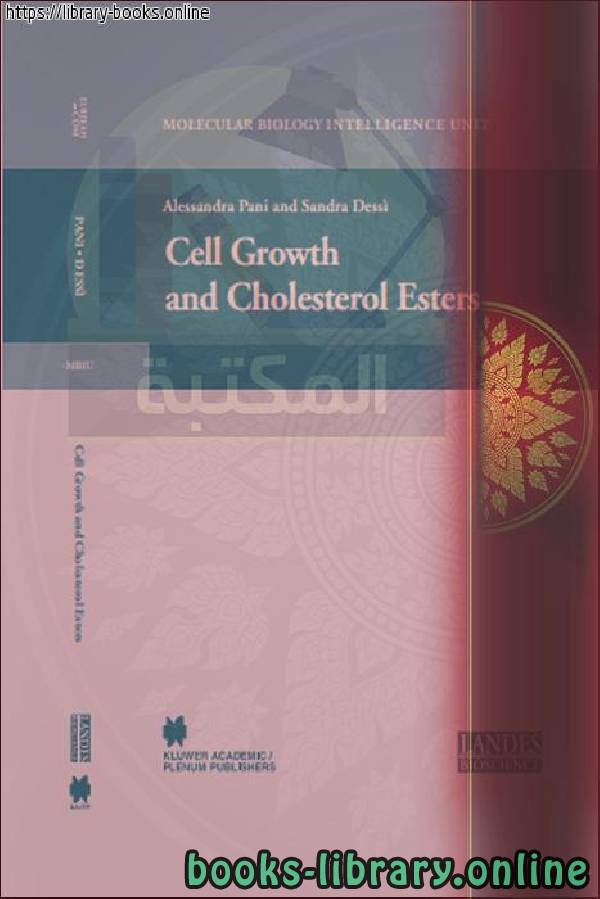📘 قراءة كتاب Molecular biology intelligence unit Sandra Dessi-Cell Growth and Cholesterol Esters أونلاين


Biologically
Biology is a natural science that is concerned with the study of life, its various forms and its function, how these organisms interact with each other and with the surrounding environment. The word biology in Greek is made up of two words: bio (βίος) meaning life. And loggia (-λογία) means science or study. Biology: the similarity of vegetation and animal cover on the edges of the African and American states, and the existence of the same fossil.
Branches of biology
Biology is an ancient science thousands of years old and modern biology began in the nineteenth century. This science has multiple branches. Among them are:
Anatomy
Botany
Biochemia
Biogeography
Biofisia
Cytology or cell science
Ecology or environmental science
نبذه عن الكتاب:
Exogenous Uptake: The LDL Receptor Pathway
Exogenous cholesterol is mainly obtained by the internalization of cholesteryl-rich lipoproteins via LDL receptor pathway.10 This pathway is known since 1973 and its discovery led
to the award of the Nobel Prize to Brown and Goldstein in 1985.
It is well known that cholesterol is a hydrophobic molecule quite insoluble in water. Thus,
it cannot pass from the liver and/or the intestine to the cells simply dissolved in blood and in
extracellular fluid. Instead it is carried in tiny droplets of lipoprotein. The most abundant
cholesterol carriers in human are the LDLs.
LDL particles are spheres with a core containing mainly cholesterol esters covered with a
single layer of phospholipid molecules with their hydrophilic heads exposed to the watery fluid
(e.g., blood) and their hydrophobic tails directed into the interior. Over a thousand molecules
of cholesterol are bound to the hydrophobic interior of LDL particles. A protein, called
apolipoprotein B-100 (ApoB-100) is exposed at the surface of each LDL particle. The first step
in acquiring LDL particles is their binding to LDL receptors that are localized at the cell surface in pits coated with clathrin, a protein involved in the formation of transport vesicles from
membranes. LDL receptor is a cell surface glycoprotein with a molecular weight of 164 kDa
having a site that recognizes and binds to the ApoB-100 on the surface of the LDL. Once LDL
binds the receptor, ligand and receptor are collected in the coated pits, and internalized to form
coated vesicles. The clathrin coat is then removed and the uncoated vesicle fuses with endosomes
to form an early sorting endosome. Here, ATP-dependent proton pumps lower the pH which
causes the LDL to separate from its receptor.
Biology
Human biology
Who is the founder of biology?
The importance of biology
Areas of work in the field of biology
Theories of biology
Research on biology for the first grade of secondary school
Human biology
سنة النشر : 2005م / 1426هـ .
حجم الكتاب عند التحميل : 3.857 .
نوع الكتاب : pdf.
عداد القراءة:
اذا اعجبك الكتاب فضلاً اضغط على أعجبني و يمكنك تحميله من هنا:

شكرًا لمساهمتكم
شكراً لمساهمتكم معنا في الإرتقاء بمستوى المكتبة ، يمكنكم االتبليغ عن اخطاء او سوء اختيار للكتب وتصنيفها ومحتواها ، أو كتاب يُمنع نشره ، او محمي بحقوق طبع ونشر ، فضلاً قم بالتبليغ عن الكتاب المُخالف:
 قبل تحميل الكتاب ..
قبل تحميل الكتاب ..
يجب ان يتوفر لديكم برنامج تشغيل وقراءة ملفات pdf
يمكن تحميلة من هنا 'http://get.adobe.com/reader/'


 منصّة المكتبة
منصّة المكتبة 